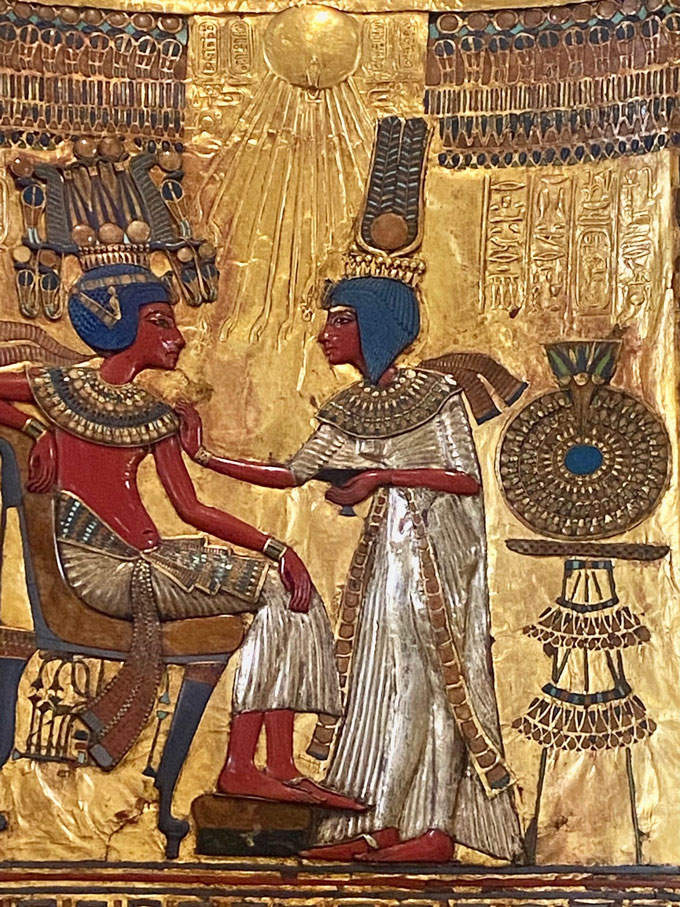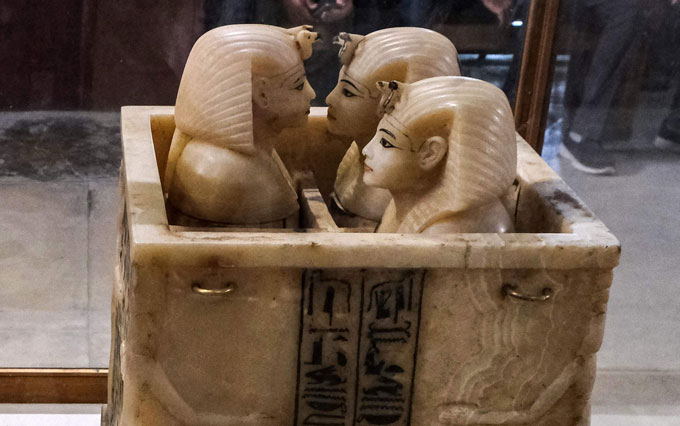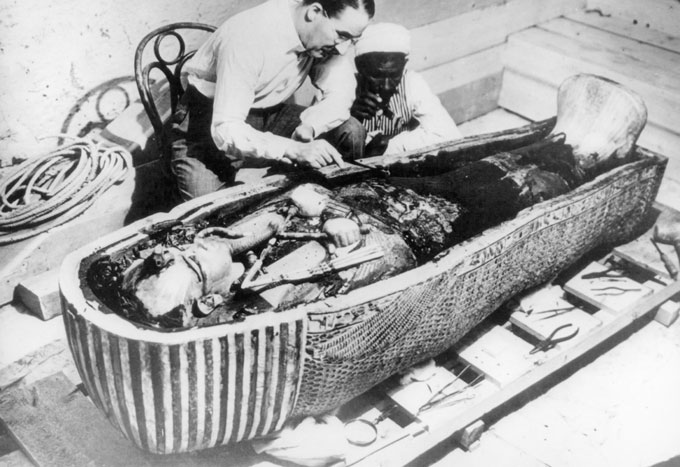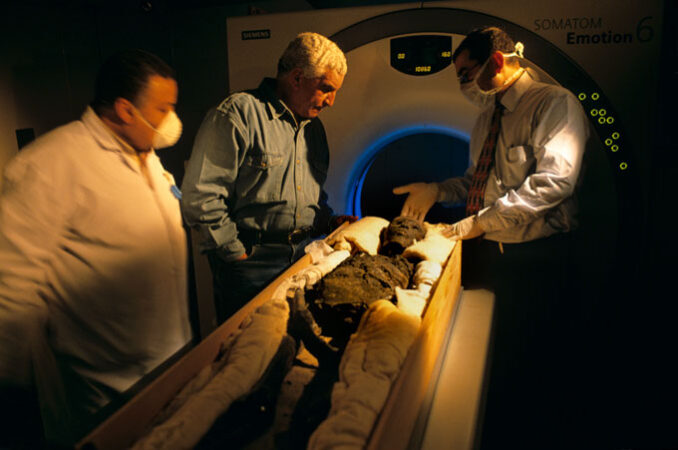This post was originally published on this site
One hundred years ago, archaeologist Howard Carter stumbled across the tomb of ancient Egypt’s King Tutankhamun. Carter’s life was never the same. Neither was the young pharaoh’s afterlife.
Newspapers around the world immediately ran stories about Carter’s discovery of a long-lost pharaoh’s grave and the wonders it might contain, propelling the abrasive Englishman to worldwide acclaim. A boy king once consigned to ancient obscurity became the most famous of pharaohs (SN: 12/18/76).
It all started on November 4, 1922, when excavators led by Carter discovered a step cut into the valley floor of a largely unexplored part of Egypt’s Valley of the Kings. By November 23, the team had uncovered stairs leading down to a door. A hieroglyphic seal on the door identified what lay beyond: King Tutankhamun’s tomb.
Tutankhamun assumed power around 1334 B.C., when he was about 10 years old. His reign lasted nearly a decade until his untimely demise. Although a minor figure among Egyptian pharaohs, Tutankhamun is one of the few whose richly appointed burial place was found largely intact.
An unusually meticulous excavator for his time, Carter organized a 10-year project to document, conserve and remove more than 6,000 items from Tutankhamun’s four-chambered tomb. While some objects, like Tut’s gold burial mask, are now iconic, many have been in storage and out of sight for decades. But that’s about to change. About 5,400 of Tutankhamun’s well-preserved tomb furnishings are slated to soon go on display when the new Grand Egyptian Museum, near the Pyramids of Giza, opens.
“The [Tut] burial hoard is something very unique,” Shirin Frangoul-Brückner, managing director of Atelier Brückner in Stuttgart, Germany, the firm that designed the museum’s Tutankhamun Gallery, said in an interview released by her company. Among other items, the exhibit will include the gold burial mask, musical instruments, hunting equipment, jewelry and six chariots.
Even as more of Tut’s story is poised to come to light, here are four things to know on the 100th anniversary of his tomb’s discovery.
1. Tut may not have been frail.
Tutankhamun has a reputation as a fragile young man who limped on a clubfoot. Some researchers suspect a weakened immune system set him up for an early death.
But “recent research suggests it’s wrong to portray Tut as a fragile pharaoh,” says Egyptologist and mummy researcher Bob Brier, who is an expert on King Tut. His new book Tutankhamun and the Tomb That Changed the World chronicles how 100 years of research have shaped both Tut’s story and archaeology itself.
Clues from Tutankhamun’s mummy and tomb items boost his physical standing, says Brier, of Long Island University in Brookville, N.Y. The young pharaoh might even have participated in warfare.
Military chariots, leather armor and archery equipment buried with Tutankhamun show that he wanted to be viewed as a hunter and a warrior, Brier says. Inscribed blocks from Tutankhamun’s temple, which were reused in later building projects before researchers identified them, portray the pharaoh leading charioteers in undated battles.
If more blocks turn up showing battle scenes marked with dates, it would suggest Tutankhamun probably participated in those conflicts, Brier says. Pharaohs typically recorded dates of actual battles depicted in their temples, though inscribed scenes may have exaggerated their heroism.
The frail story line has been built in part on the potential discovery of a deformity in Tut’s left foot, along with 130 walking sticks found in his tomb. But ancient Egyptian officials were often depicted with walking sticks as signs of authority, not infirmity, Brier says. And researchers’ opinions vary about whether images of Tut’s bones reveal serious deformities.
X-rays of the recovered mummy from the 1960s show no signs of a misshapen ankle that would have caused a limp. Neither did CT images examined in 2005 by the Egyptian Mummy Project, headed by Egyptologist and former Egyptian Minister of Antiquities Zahi Hawass.
Then a 2009 reexamination of the CT images by the same researchers indicated that Tutankhamun had a left-foot deformity generally associated with walking on the ankle or the side of the foot, the team reported. The team’s radiologist, Sahar Saleem of Egypt’s Cairo University, says the CT images show that Tutankhamun experienced a mild left clubfoot, bone tissue death at the ends of two long bones that connect to the second and third left toes and a missing bone in the second left toe.

Those foot problems would have “caused the king pain when he walked or pressed his weight on his foot, and the clubfoot must have caused limping,” Saleem says. So a labored gait, rather than an appeal to royal authority, could explain the many walking sticks placed in Tutankhamun’s tomb, she says.
Brier, however, doubts that scenario. Tutankhamun’s legs appear to be symmetrical in the CT images, he says, indicating that any left foot deformity was too mild to cause the pharaoh regularly to put excess weight on his right side while walking.
Whether or not the boy king limped through life, the discovery and study of his mummy made it clear that he died around age 19, on the cusp of adulthood. Yet Tut’s cause of death still proves elusive.
In a 2010 analysis of DNA extracted from the pharaoh’s mummy, Hawass and colleagues contended that malaria, as well as the tissue-destroying bone disorder cited by Saleem from the CT images, hastened Tutankhamun’s death. But other researchers, including Brier, disagree with that conclusion. Further ancient DNA studies using powerful new tools for extracting and testing genetic material from the mummy could help solve that mystery.
2. Tut’s initial obscurity led to his fame.
After Tutankhamun’s death, ancient Egyptian officials did their best to erase historical references to him. His reign was rubbed out because his father, Akhenaten, was a “heretic king” who alienated his own people by banishing the worship of all Egyptian gods save for one.
“Akhenaten is the first monotheist recorded in history,” Brier says. Ordinary Egyptians who had prayed to hundreds of gods suddenly could worship only Aten, a sun god formerly regarded as a minor deity.
Meeting intense resistance to his banning of cherished religious practices, Akhenaten — who named himself after Aten — moved to an isolated city, Amarna, where he lived with his wife Nefertiti, six girls, one boy and around 20,000 followers. After Akhenaten died, residents of the desert outpost returned to their former homes. Egyptians reclaimed their old-time religion. Akhenaten’s son, Tutankhaten — also originally named after Aten — became king, and his name was changed to Tutankhamun in honor of Amun, the most powerful of the Egyptian gods at the time.
Later pharaohs omitted from written records any mentions of Akhenaten and Tutankhamun. Tut’s tomb was treated just as dismissively. Huts of craftsmen working on the tomb of King Ramses VI nearly 200 years after Tut’s death were built over the stairway leading down to Tutankhamun’s nearby, far smaller tomb. Limestone chips from the construction littered the site.

The huts remained in place until Carter showed up. While Carter found evidence that the boy king’s tomb had been entered twice after it was sealed, whoever had broken in took no major objects.
“Tutankhamun’s ignominy and insignificance saved him” from tomb robbers, says UCLA Egyptologist Kara Cooney.
3. Tut’s tomb was a rushed job.
Pharaohs usually prepared their tombs over decades, building many rooms to hold treasures and extravagant coffins. Egyptian traditions required the placement of a mummified body in a tomb about 70 days after death. That amount of time may have allowed a mummy to dry out sufficiently while retaining enough moisture to fold the arms across the body inside a coffin, Brier suspects.
Because Tutankhamun died prematurely, he had no time for extended tomb preparations. And the 70-day burial tradition gave craftsmen little time to finish crucial tomb items, many of which required a year or more to make. Those objects include a carved stone sarcophagus that encased three nested coffins, four shrines, hundreds of servant statues, a gold mask, chariots, jewelry, beds, chairs and an alabaster chest that contained four miniature gold coffins for Tutankhamun’s internal organs removed during mummification.
Evidence points to workers repurposing many objects from other people’s tombs for Tutankhamun. Even then, time ran out.
Consider the sarcophagus. Two of four goddesses on the stone container lack fully carved jewelry. Workers painted missing jewelry parts. Carved pillars on the sarcophagus are also unfinished.
Tutankhamun’s granite sarcophagus lid, a mismatch for the quartzite bottom, provides another clue to workers’ frenzied efforts. Something must have happened to the original quartzite lid, so workers carved a new lid from available granite and painted it to look like quartzite, Brier says.
Repairs on the new lid indicate that it broke in half during the carving process. “Tutankhamun was buried with a cracked, mismatched sarcophagus lid,” Brier says.
Tutankhamun’s sarcophagus may originally have been made for Smenkare, a mysterious individual who some researchers identify as the boy king’s half brother. Little is known about Smenkare, who possibly reigned for about a year after Akhenaten’s death, just before Tutankhamun, Brier says. But Smenkare’s tomb has not been found, leaving the sarcophagus puzzle unsolved.
Objects including the young king’s throne, three nested coffins and the shrine and tiny coffins for his internal organs also contain evidence of having originally belonged to someone else before being modified for reuse, says Harvard University archaeologist Peter Der Manuelian.

Even Tutankhamun’s tomb may not be what it appears. Egyptologist Nicholas Reeves of the University of Arizona Egyptian Expedition in Tucson has argued since 2015 that the boy king’s burial place was intended for Nefertiti. He argues that Nefertiti briefly succeeded Akhenaten as Egypt’s ruler and was the one given the title Smenkare.
No one has found Nefertiti’s tomb yet. But Reeves predicts that one wall of Tutankhamun’s burial chamber blocks access to a larger tomb where Nefertiti lies. Painted scenes and writing on that wall depict Tutankhamun performing a ritual on Nefertiti’s mummy, he asserts. And the gridded structure of those paintings was used by Egyptian artists years before Tutankhamun’s burial but not at the time of his interment.
But four of five remote sensing studies conducted inside Tutankhamun’s tomb have found no evidence of a hidden tomb. Nefertiti, like Smenkare, remains a mystery.
4. Tut’s tomb changed archaeology and the antiquities trade.
Carter’s stunning discovery occurred as Egyptians were protesting British colonial rule and helped fuel that movement. Among the actions that enraged Egyptian officials: Carter and his financial backer, a wealthy British aristocrat named Lord Carnarvon, sold exclusive newspaper coverage of the excavation to The Times of London. Things got so bad that Egypt’s government locked Carter out of the tomb for nearly a year, starting in early 1924.
Egyptian nationalists wanted political independence — and an end to decades of foreign adventurers bringing ancient Egyptian finds back to their home countries. Tutankhamun’s resurrected tomb pushed Egyptian authorities toward enacting laws and policies that helped to end the British colonial state and reduce the flow of antiquities out of Egypt, Brier says, though it took decades. Egypt became a nation totally independent of England in 1953. A 1983 law decreed that antiquities could no longer be taken out of Egypt (though those removed before 1983 are still legal to own and can be sold through auction houses).
In 1922, however, Carter and Lord Carnarvon regarded many objects in Tutankhamun’s tomb as theirs for the taking, Brier says. That was the way that Valley of the Kings excavations had worked for the previous 50 years, in a system that divided finds equally between Cairo’s Egyptian Museum and an expedition’s home institution. Taking personal mementos was also common.
Evidence of Carter’s casual pocketing of various artifacts while painstakingly clearing the boy king’s tomb continues to emerge. “Carter didn’t sell what he took,” Brier says. “But he felt he had a right to take certain items as the tomb’s excavator.”

Recently recovered letters of English Egyptologist Alan Gardiner from the 1930s, described by Brier in his book, recount how Carter gave Gardiner several items from Tutankhamun’s tomb, including an ornament used as a food offering for the dead. French Egyptologist Marc Gabolde of Paul-Valéry Montpellier 3 University has tracked down beads, jewelry, a headdress fragment and other items taken from Tutankhamun’s tomb by Carter and Carnarvon.
Yet it is undeniable that one of Tutankhamun’s greatest legacies, thanks to Carter, is the benchmark the excavation of his tomb set for future excavations, Brier says. Carter started his career as an artist who copied painted images on the walls of Egyptian tombs for excavators. He later learned excavation techniques in the field working with an eminent English Egyptologist, Flinders Petrie. Carter took tomb documentation to a new level, rounding up a crack team consisting of a photographer, a conservator, two draftsmen, an engineer and an authority on ancient Egyptian writing.
Their decade-long effort also made possible the new Tutankhamun exhibition at the Grand Egyptian Museum. Now, not only museum visitors but also a new generation of researchers will have unprecedented access to the pharaoh’s tomb trove.
“Most of Tutankhamun’s [tomb] objects have been given little if any study beyond what Carter was able to do,” says UCLA’s Cooney.
That won’t be true for much longer, as the most famous tomb in the Valley of the Kings enters the next stage of its public and scientific afterlife.
